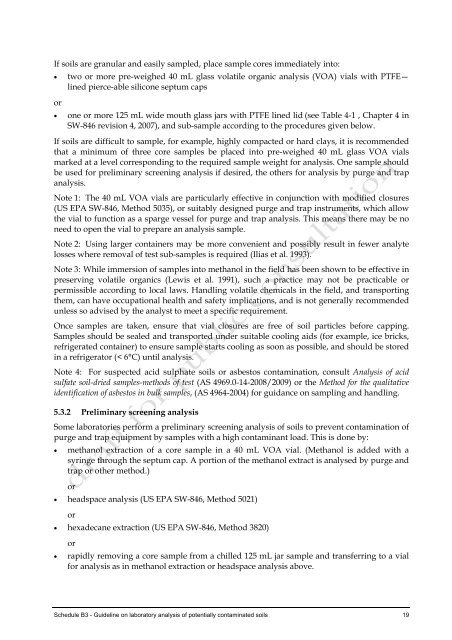Schedule B3 - COAG Standing Council on Environment and Water
Schedule B3 - COAG Standing Council on Environment and Water
Schedule B3 - COAG Standing Council on Environment and Water
- No tags were found...
Create successful ePaper yourself
Turn your PDF publications into a flip-book with our unique Google optimized e-Paper software.
If soils are granular <strong>and</strong> easily sampled, place sample cores immediately into:<br />
• two or more pre-weighed 40 mL glass volatile organic analysis (VOA) vials with PTFE—<br />
lined pierce-able silic<strong>on</strong>e septum caps<br />
or<br />
• <strong>on</strong>e or more 125 mL wide mouth glass jars with PTFE lined lid (see Table 4-1 , Chapter 4 in<br />
SW-846 revisi<strong>on</strong> 4, 2007), <strong>and</strong> sub-sample according to the procedures given below.<br />
If soils are difficult to sample, for example, highly compacted or hard clays, it is recommended<br />
that a minimum of three core samples be placed into pre-weighed 40 mL glass VOA vials<br />
marked at a level corresp<strong>on</strong>ding to the required sample weight for analysis. One sample should<br />
be used for preliminary screening analysis if desired, the others for analysis by purge <strong>and</strong> trap<br />
analysis.<br />
Note 1: The 40 mL VOA vials are particularly effective in c<strong>on</strong>juncti<strong>on</strong> with modified closures<br />
(US EPA SW-846, Method 5035), or suitably designed purge <strong>and</strong> trap instruments, which allow<br />
the vial to functi<strong>on</strong> as a sparge vessel for purge <strong>and</strong> trap analysis. This means there may be no<br />
need to open the vial to prepare an analysis sample.<br />
Note 2: Using larger c<strong>on</strong>tainers may be more c<strong>on</strong>venient <strong>and</strong> possibly result in fewer analyte<br />
losses where removal of test sub-samples is required (Ilias et al. 1993).<br />
Note 3: While immersi<strong>on</strong> of samples into methanol in the field has been shown to be effective in<br />
preserving volatile organics (Lewis et al. 1991), such a practice may not be practicable or<br />
permissible according to local laws. H<strong>and</strong>ling volatile chemicals in the field, <strong>and</strong> transporting<br />
them, can have occupati<strong>on</strong>al health <strong>and</strong> safety implicati<strong>on</strong>s, <strong>and</strong> is not generally recommended<br />
unless so advised by the analyst to meet a specific requirement.<br />
Once samples are taken, ensure that vial closures are free of soil particles before capping.<br />
Samples should be sealed <strong>and</strong> transported under suitable cooling aids (for example, ice bricks,<br />
refrigerated c<strong>on</strong>tainer) to ensure sample starts cooling as so<strong>on</strong> as possible, <strong>and</strong> should be stored<br />
in a refrigerator (< 6°C) until analysis.<br />
Note 4: For suspected acid sulphate soils or asbestos c<strong>on</strong>taminati<strong>on</strong>, c<strong>on</strong>sult Analysis of acid<br />
sulfate soil-dried samples-methods of test (AS 4969.0-14-2008/2009) or the Method for the qualitative<br />
identificati<strong>on</strong> of asbestos in bulk samples, (AS 4964-2004) for guidance <strong>on</strong> sampling <strong>and</strong> h<strong>and</strong>ling.<br />
5.3.2 Preliminary screening analysis<br />
Some laboratories perform a preliminary screening analysis of soils to prevent c<strong>on</strong>taminati<strong>on</strong> of<br />
purge <strong>and</strong> trap equipment by samples with a high c<strong>on</strong>taminant load. This is d<strong>on</strong>e by:<br />
• methanol extracti<strong>on</strong> of a core sample in a 40 mL VOA vial. (Methanol is added with a<br />
syringe through the septum cap. A porti<strong>on</strong> of the methanol extract is analysed by purge <strong>and</strong><br />
trap or other method.)<br />
or<br />
• headspace analysis (US EPA SW-846, Method 5021)<br />
or<br />
• hexadecane extracti<strong>on</strong> (US EPA SW-846, Method 3820)<br />
or<br />
• rapidly removing a core sample from a chilled 125 mL jar sample <strong>and</strong> transferring to a vial<br />
for analysis as in methanol extracti<strong>on</strong> or headspace analysis above.<br />
<str<strong>on</strong>g>Schedule</str<strong>on</strong>g> <str<strong>on</strong>g>B3</str<strong>on</strong>g> - Guideline <strong>on</strong> laboratory analysis of potentially c<strong>on</strong>taminated soils 19
















